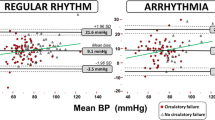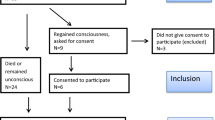Abstract
The objective of the study was assess the utility during anaesthesia of noninvasive continuous blood pressure measurement techniques which use intermittent oscillometric blood pressure measurement for their calibration. The assessment was performed by comparing noninvasive blood pressure with intra-arterial blood pressure. The noninvasive blood pressure measurement device used for evaluation was the NCAT N-500 which uses tonometry for its continuous measurements. Fifteen patients were studied. In 10 patients the intra-arterial blood pressure curve (IBP) was recorded from the radial artery (radial artery group), and in 5 patients it was recorded from the brachial artery (brachial artery group). In all patients the oscillometrically calibrated tonometric blood pressure (OTBP) was recorded from the other arm. To discriminate between calibration dependent measurement error and tonometric measurement error, the OTBP signal was recalibrated against the IBP signal to get the intra-arterial calibrated tonometric pressure curve (ITBP). OTBP-IBP reflected the overall measurement error, ITBP-IBP the error of the tonometric measurement, and OTBP-ITBP the calibration dependent measurement error. According to criteria formulated in the discussion the accuracy and agreement of the ITBP-IBP measurements were clinical acceptable. Accuracy and agreement of OTBP-IBP and of OTBP-ITBP were not clinical acceptable. Correlation of dynamic behavior was lower for OTBP than for ITBP. A significant effect of site difference between calibration measurements and continuous measurements was not found. It is concluded that the approach of continuous noninvasive blood pressure measurement based on the combination of two different measurement methods, in which the continuous method is calibrated by the oscillometric method, lead to clinical unacceptable accuracy and agreement in the patient group studied.
Similar content being viewed by others
References
Wesseling KH, de Wit B, Settels JJ, Klawer WH. On the indirect registration of finger blood pressure after Peñáz. Funkt Biol Med 1982; 1: 245–250.
de Jong JR, Tepaske R, Scheffer GJ, Ros HH, Sipkema PP, de Lange JJ. Noninvasive continuous blood pressure measurement: a clinical evaluation of the Cortronic APM 770. J Clin Monit 1993; 1: 18–24.
Understanding continuous, noninvasive blood pressure measurements using sentinel monitoring's ARTRAC(TM) Monitor. Sentinel Monitoring Inc., Indianapolis, Indiana, 1991.
Kemmotsu O, Ueda M, Otsuka H, Yamamura T, Winter DC, Eckerle JS. Arterial tonometry for noninvasive, continuous blood pressure monitoring during anesthesia. Anesthesiology 1991; 75: 333–340.
Kemmotsu O, Ueda M, Otsuka H, Yamamura T, Okamura A, Ishikawa T, Winter DC, Eckerle JS. Blood pressure measurement by arterial tonometry in controlled hypotension. Anesth Analg 1991, 73: 54–58.
Searle NR, Perrault J, Ste-Marie H, Dupont C. Assessment of the arterial tonometer (N-CAT) for the continuous blood pressure measurement in rapid atrial fibrillation. Can J Anaesth 1993; 40: 388–93.
Ramsay M. III. Blood pressure monitoring: automated oscillometric devices. J Clin Monit 1991; 7: 56–67.
Gardner RM. Direct blood pressure measurement — Dynamic response requirements. Anesthesiology 1981; 54: 227–36.
Bland JM, Altman DG. Statistical methods for assessing agreement between two methods of clinical measurement. Lancet 1986: 307–310.
Whalen P, Ream AK. A quantitative evaluation of the Hewlett-Packard 78354A noninvasive blood pressure meter. J Clin Monit 1988; (4): 21–30.
Pace NL, East TD. Simultaneous comparison of intraarterial, oscillometric, and Finapres monitoring during anesthesia. Anesth Analg 1991; 73: 213–20.
Rutten AJ, Ilsley AH, Skowronski GA, Runciman WB. A Comparative study of the measurement of mean arterial blood pressure using automatic oscillometers, arterial cannulation and auscultation. Anaesth Intens Care 1986; 14: 58–65.
Gorback MS, Quill TJ, Lavine ML. The relative accuracies of two automated noninvasive arterial pressure measurement devices. J Clin Monit 1991; (7): 13–22.
Gibbs NM, Larach DR, Derr JA. The accuracy of Finapres noninvasive mean arterial pressure measurements in anesthetized patients. Anesthesiology 1991; 74: 647–652.
Gourdeau M, Martin R, Lamarche Y, Tetreault L. Oscillometry and direct blood pressure: a comparative clinical study during deliberate hypotension. Can Anaesth Soc J 1986; 33: 300–307.
Author information
Authors and Affiliations
Rights and permissions
About this article
Cite this article
De Jong, J.R., Ros, H.H. & De Lange, J.J. Noninvasive continuous blood pressure measurement during anaesthesia: A clinical evaluation of a method commonly used in measuring devices. J Clin Monit Comput 12, 1–10 (1995). https://doi.org/10.1007/BF01142439
Accepted:
Issue Date:
DOI: https://doi.org/10.1007/BF01142439




